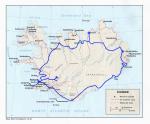Yesterday we went to another tomb close to Xi’an – the tomb of emperor Jingdi who ruled in 188 BC–141 BC. This tomb was discovered by highway construction crew in 1990.
We had to take two busses to get to the tomb but on the first one we were told that the second bus wouldn’t go until thee hours later. Fortunately we were rescued by five local ladies (one spoke English) that were also going to the tomb. With them we took a local bus to the middle of nowhere and walked for 25 minutes until we found the tomb. The ladies were great fun, always laughing and joking around – and really helpful and took care of us in the museum and took us back to Xi’an after the visit. The Chinese people seem really cheerful and very helpful – even though the language is often an obstacle.
While emperor Qin was said to have ruled with an iron first, emperor Jingdi was a just and fair and ruled according with Taoist believes of going with the flow – he seems like he had a lot in common with the laissez-faire capitalists that have been ruling the western world for the last 10-15 years. He lowered taxes, used diplomacy rather than force and shrunk the state – and the people prospered.
The tomb was similar to the terracotta army in some ways, it contains many terracotta figures but most of them are quite small – the men about two feet high (Maybe the emperor thought he might spend the afterlife in Lilliput) and not so much army focused, more just items from regular life. The museum facilities are cleverly constructed and you can get very close to some of the artifacts. There are glass tunnels above and at the side of the excavation pits where you get a good view everything.
The highlight for me was a holographic 3-D movie telling the story of the emperor and his wife – or so we think. The movie was only available in Chinese :) I hadn’t seen such a holographic movie before and was fascinated with the technology. The movie was shown in a small room and the stage and the figures were quite small, about a foot high. It was amazing how the figures and the props interacted with the real stage. Elínborg was less impressed but I was just fascinated. Just imagine the possibilities for theatre and live performances. We could be watching plays with the best actors in the world “live” but at a fraction of the current cost. I think that the 3-D phase that cinema is going through now will be short lived and holograms will take over – or maybe these technologies can work together?
After we returned to Xi’an Yong and Mr. Lee took us for dinner and a few beers. He took us to a special Xi’an barbecue place that served meat, bread and vegetables. It seemed like everything (meat, bread and vegetables) was put on skewers and fried and then coated with a spicy herbal seasoning and barbecued. We had some beef, mutton, bread and bread balls with vegetables and like when we had the hotpot, everything was extremely good. Yong told us that Xi’an is famous for its noodles and ordered one portion of noodles for us to try. The noodles were wheat noodles hand made in the restaurant boiled and then covered with some hot oil and chilies and tasted great as everything that Yong has offered us – surely the best noodles that we have had.
It is strange that we have been struggling to find good places to eat in but when we are taken out by locals we have these wonderful meals. There seems to be a some sort of disconnect here. I have heard the same stories from people visiting China that the food is a problem but then fantastic meals are just waiting around the corner.
Now we are just preparing for the 16 hours train ride to Shanghai where we will arrive around noon tomorrow. Yong has told us how nice Shanghai is and we are really looking forward to seeing for our selves.
























